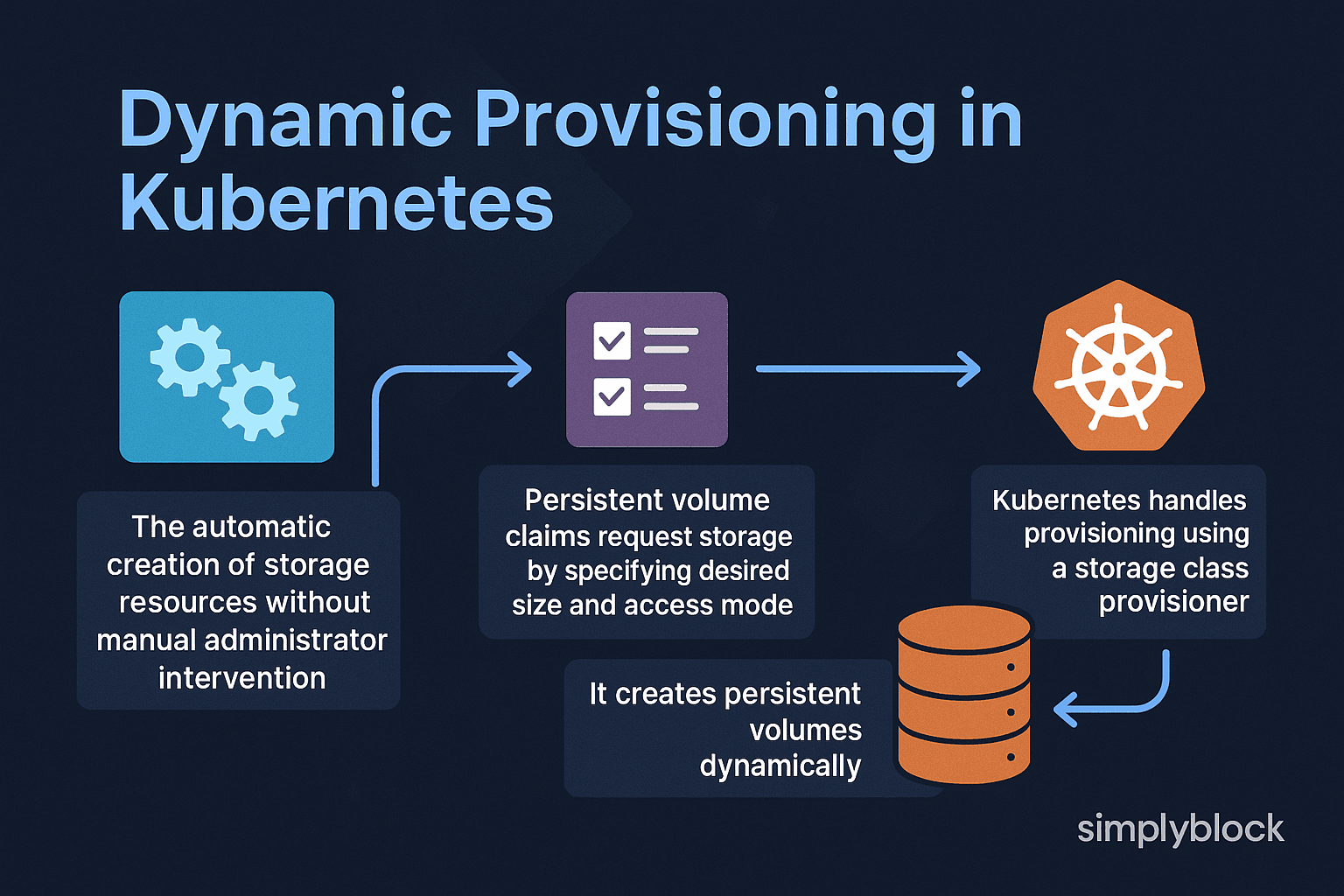Dynamic Provisioning in Kubernetes
Terms related to simplyblock
Dynamic provisioning in Kubernetes refers to the automated creation of persistent storage volumes based on demand, without requiring manual pre-provisioning of storage by a cluster administrator. This enables developers and workloads to request storage through a PersistentVolumeClaim (PVC), which the Kubernetes control plane fulfills by invoking a StorageClass and a Container Storage Interface (CSI) driver.
Unlike static provisioning—where volumes must be manually created and mapped—dynamic provisioning supports on-demand, scalable, and declarative storage management. It is essential for cloud-native, multi-tenant environments where infrastructure must respond quickly to workload changes.
Platforms like simplyblock offer high-performance NVMe-backed dynamic provisioning with block storage volumes, enabling seamless scaling, cloning, and snapshotting of storage in Kubernetes clusters.
How Dynamic Provisioning Works
The dynamic provisioning process in Kubernetes involves:
- PersistentVolumeClaim (PVC): A user requests a volume with a specific size and access mode.
- StorageClass: Defines the provisioner (CSI driver), parameters (e.g., volume type), and reclaim policy.
- CSI Driver: Interfaces with the storage backend (e.g., simplyblock) to create the volume.
- PersistentVolume (PV): Automatically created and bound to the PVC.
This entire process is managed by Kubernetes controllers, allowing developers to declare their storage needs without dealing with backend infrastructure.
Benefits of Dynamic Provisioning
Dynamic provisioning is essential for modern DevOps workflows and platform engineering. Key benefits include:
- Self-service storage: Developers can request volumes without IT intervention.
- Improved agility: Volumes are created in real time based on workload requirements.
- Policy-based control: Admins can define performance tiers, volume types, and replication settings via StorageClasses.
- Optimized resource use: Prevents unused volumes by provisioning only when needed.
- Automation and scale: Works seamlessly with StatefulSets, Helm charts, and CI/CD pipelines.
When paired with erasure coding and QoS policies, dynamic provisioning ensures high-performance and resilient storage allocation.

Use Cases for Dynamic Provisioning
- Stateful Kubernetes workloads: PostgreSQL, MongoDB, Redis, Cassandra
- CI/CD pipelines: Create and destroy storage volumes on the fly for test environments
- Multi-tenant platforms: Enable namespace-specific volume provisioning
- Hybrid cloud deployments: Dynamically attach storage in multi-zone clusters with unified orchestration
- Application scaling: Automatic storage allocation when deploying with StatefulSets
Dynamic vs Static vs Ephemeral Provisioning
There are three common methods of provisioning storage in Kubernetes:
| Feature | Dynamic Provisioning | Static Provisioning | Ephemeral Storage |
|---|---|---|---|
| Volume Creation | On demand via PVC | Pre-created by admin | Created and deleted with pod |
| CSI Driver Required | Yes | Optional | Optional |
| Persistent | Yes | Yes | No |
| Suitable for Databases | Yes | Yes | No |
| Automation Level | High | Manual | Automatic, pod-bound |
Dynamic Provisioning in Simplyblock™
Simplyblock delivers robust, NVMe-based dynamic provisioning for Kubernetes clusters:
- CSI-compliant driver for Kubernetes, OpenShift, and Rancher
- Sub-millisecond latency via NVMe-over-TCP
- Instant volume creation with snapshot, clone, and resize support
- Integrated multi-tenancy controls and performance isolation
- Resilience through erasure-coded backend
Developers and DevOps teams benefit from a fast, secure, and policy-driven storage provisioning layer built for cloud-native scale.
External Resources
- Dynamic Volume Provisioning – Kubernetes Docs
- Storage Classes – Kubernetes Docs
- CSI Volume Provisioning – Kubernetes
- Persistent Volumes and Claims – Red Hat OpenShift
- Amazon EBS CSI Driver for Kubernetes
Questions and Answers
Dynamic provisioning in Kubernetes automates the creation of storage volumes when a PersistentVolumeClaim (PVC) is submitted. Instead of requiring pre-created volumes, Kubernetes uses a CSI driver to create volumes on demand based on defined storage classes.
Dynamic provisioning eliminates manual volume setup, enabling scalable, automated storage for stateful apps like databases and queues. When paired with Kubernetes-native NVMe storage, it ensures fast, reliable storage without admin overhead.
Yes. Using a CSI-compatible driver, Kubernetes can dynamically provision volumes from NVMe over TCP storage backends—delivering high IOPS and low latency for performance-critical workloads.
When used with storage platforms that support encryption at rest and per-volume isolation, dynamic provisioning remains secure. Each PVC can be tied to its own encrypted volume, ensuring tenant separation and compliance.
Dynamic provisioning is used for deploying databases, message brokers, analytics tools, and any application that needs persistent storage. It simplifies DevOps workflows and scales with modern software-defined storage environments in real time.
